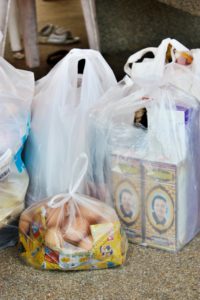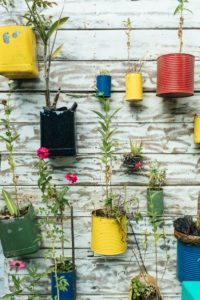Why is it important?
Humanitarian organisations are often operating in areas with limited or non-existent recycling infrastructure and that are already experiencing environmental degradation. Plastic packaging for goods that humanitarian organisations supply to these areas has the potential to further exacerbate the local plastic pollution problem. The extraction of fossil fuels for plastic production, the production and end-of-life management of plastics also contribute to ocean pollution, ecosystem and human health perturbation, and of course global warming: in 2019, plastics were responsible for 3.4% of global greenhouse gas emissions. (1)
The most common plastic packaging types used by humanitarian organisations for the delivery of food aid are Polyethylene terephthalate (PET), e.g. used for oil/water bottles, high-density polyethylene (HDPE), used in vegetable oil containers and polypropylene (PP), e.g. used in woven bags for commodities such as rice and sorghum. (2)
What is the solution?
Before considering alternative materials for their plastic packaging, always consider first if the packaging can be eliminated or reduced. Then, adopting more eco-friendly materials can reduce the impact of packaging raw materials in supply chains. Yet, as the Joint Initiative notes: “Although alternatives to plastic may help reduce the plastic pollution problem linked to poor end-of-life management, they should not be considered quick-fix solutions […].” (3) And whilst certain alternative materials have a lesser environmental impact in some areas, they might have a higher impact in others. Also, carefully evaluate biodegradable and bio-sourced alternatives before switching materials: First, biodegradable and bio-sourced plastics do not automatically go together. Second, biodegradable plastics may require specific conditions to effectively degrade. (4)
Alternative materials
Cardboard/paper
Cardboard can be brown or white. Brown cardboard is usually made from 100% natural materials but does not automatically come from recycled materials. White cardboard was bleached and should be avoided.
Recycled plastics
Recycled plastics are plastics that are made partially or sometimes fully from recycled petroleum-based plastics.
Biodegradable plastics
Biodegradable plastics are composed of materials that can be broken down by microorganisms, such as bacteria and fungi. They only break down completely if exposed to specific conditions (humidity, temperature).
Compostable plastics
Compostable and biodegradable are terms often used interchangeably but they have distinct differences. While all compostable plastics are biodegradable, not all biodegradable plastics are compostable. Compostable plastics are typically made from organic materials such as field corn and cellulose, which facilitate easier breakdown.
Bio-based plastics
Bio-based plastics are made partially or fully from plant/renewable materials (e.g., sugar cane, maize, coco husk waste or natural polymers/fibres such as starch, cellulose and bamboo). Some bio-based plastics are biodegradable, but others are not.
Bio-regenerative materials (seaweed, hemp, mushrooms)
Regenerative materials offer a more efficient land use compared to biobased materials, as they require no pesticides and, especially in the case of seaweed, no fresh water. These materials are abundant and widely available, with seaweed being particularly prevalent. Bioregenerative materials are typically 100% home compostable, although some may still contain a mixture of fossil fuel polymers.
Natural fibres (jute and cotton)
Includes packaging made from materials such as jute or cotton, typically used as a replacement for single use plastics bags.
Note
Image

Key actions
-
#1 Make an inventory and prioritise
Conduct an inventory of the current packaging materials used by the concerned organisation. This includes identifying the types of materials, quantities, and their environmental impact. Focus on items that are sourced in large quantities first, then access the recycling capacities available in your area of operation.
-
#2 Assess packaging needs
Assess the specific packaging needs for the identified items. Consider the requirements for product protection, transportation, storage, and distribution while minimising waste generation. Consider reusing packaging when feasible.
-
#3 Engage with suppliers
Evaluate alternative packaging materials and methods to reduce environmental impact in close collaboration with suppliers and eventually local producers. Consider materials with a lower carbon footprint, renewable resources, recyclability, composability, and reduced energy consumption.
-
#4 Switch from multi to mono-material packaging
The combination of multiple materials, e.g. combining plastic and aluminium layers, are economically, and in some cases even technically, not recyclable. (10) Switch to mono-materials, wherever possible.
-
#5 Consider adapting the product format
Explore possibilities to changing the product format to allow for alternative material use. For example, switch from liquid cleaning products to solid, concentrated products. The approach also avoids shipping water, thereby reducing transport emissions.
-
#6 Run a pilot
Test the identified alternative packaging solutions on a smaller scale to assess their feasibility, functionality, and effectiveness. Consider product compatibility, durability, safety, and cost implications.
-
#7 Implement and evaluate
Once a viable alternative packaging solution is identified, plan for its implementation across your organisation’s operations. Regularly evaluate and monitor the implemented packaging solution’s performance. Collect feedback from stakeholders, assess its environmental impact, and make necessary adjustments to optimise sustainability efforts further.
-
#8 Collaborate
Engage with other humanitarian organisations, industry experts, universities and sustainable packaging initiatives to share knowledge, experiences, and best practices. Team up with other organisations to jointly request improvements to packaging materials from key suppliers. Share your success stories with CAA.
To consider
-
Potential co-benefits
- Reduced local pollution when using reusable packaging, home-compostable, or materials that naturally degrade
- Employee engagement: promoting sustainability engages employees, fosters a culture of sustainability, and increases job satisfaction.
- Reduced transport cost and emissions when making changes to the product format itself (e.g. concentrated, solid product instead of liquid product)
-
Success conditions
- Make reducing the impact of packaging a strategic issue
- Designate a responsible person or department to implement the sustainable packaging strategy
- Ensure good knowledge of the specific packaging requirements
- Engage with suppliers to better understand the possibilities and constraints when changing materials
- If sufficient data is available, set a plastic packaging goal (e.g. % of recycled content, % of using alternative materials)
- Involving staff from the quality and procurement department
-
Prerequisites & specificities
- Overview of type of packaging and the materials used
- Availability: some alternatives are at early development stages and might not yet be broadly available or adapted to the specific humanitarian context
-
Potential Risks
- Alternative materials might come with a price add-on
- Biodegradable materials might have a shorter life cycle, leading to reduced shelf life
- Quality issues or damage to items or food if alternative material is not adequate
Tools and good practices
-
A list of alternative packaging material for non-food items
UK HSOT suppliers of non-food items (NFI) items must ensure that the packaging is free from single-use plastic. In their guidance note for suppliers, UK HSOT provides a list of alternative packaging material that should be used instead.
Read here -
Flexi-Hex packaging sleeve
The Flexi-Hex® is an innovative, protective packaging sleeve made from 100% recycled paper that helps protect fragile products in transit. Flexi-Hex is an alternative for unsustainable bubble wrap and air filled plastic.
Read here -
Everdrop cleaning and laundry products
By offering cleaning and laundry products in a concentrated, solid format, the startup everdrop does not only avoid single-use plastic packaging, but also reduces emissions from transport.
Read here -
Packaging made from mushrooms
The company Ecovative uses mushroom mycelium, a natural and biodegradable alternative to plastic-based materials to create products, from packaging to building materials.
Read here -
Packaging made from seaweed-based plastic
The plastic, called "Agile", is made from seaweed called Ascophyllum nodosum. It is biodegradable and home-compostable, meaning bacteria and fungi can break it down outside industrial composting conditions. The packaging is already available for catering services in the UK.
Read here -
Packaging factsheets, The Food Packaging Forum, 2023
The Food Packaging Forum provides information and resources on food packaging, including a number of packaging fact sheets summarising the environmental impacts of different types of packaging.
Read here
To go further
-
Alternatives to conventional (petroleum-based) plastics in packaging, Joint Initiative, 2023
The document provides an overview of different packaging materials, such as biodegradable plastics, recyclable plastics, paper and cardboard, and glass. It concludes by calling for more research and development into sustainable packaging alternatives.
Read here -
Drowning in plastics, UNEP, 2021
Chapter 19 of the report discusses the pros and cons of biodegradable plastics and bioplastics.
Read here -
Are Biodegradable and Compostable Plastics Really Sustainable?, WWF, 2022
Biodegradable and compostable plastics are often marketed as environmentally friendly alternatives to conventional plastics. However, these plastics may only sometimes break down as intended and can still have negative environmental impacts.
Read here




